The Japanese woman or the Japanese diet was developed by nutritionists at the YaELO Clinic (Yaeks). The principle of the technique is based on the use of low-calorie foods for 7-14 days. Before starting a strict diet, experts recommend mental preparation - the weight loss system requires strict adherence to all the rules of the method. This system of getting rid of excess weight is characterized by a long exit: it lasts for 4 weeks. Despite its high effectiveness, diet can damage the body, especially in case of contraindications.

The principle of weight loss
The Japanese diet was designed for 7, 14, or 13 days. The right weight loss is done by using foods high in protein. Foods high in carbohydrates and fats are excluded from the diet. The technique is considered "salt-free". The initial stage of weight loss is accompanied by the normalization of metabolic processes in the body, the removal of toxins.
It is impossible to deviate from the system - the diet is strictly prescribed. As there is not enough carbohydrate in the food, the duration of the diet should not exceed 14 days. The onset of side effects requires immediate discontinuation of diet therapy and this is the reason for contacting a health care provider. The use of vitamins and minerals is encouraged during weight loss, the complex is selected individually. It can take up to a month to exit the diet.
Nutrition rules

Foods made from approved foods can fill up quickly. This is due to the fact that their composition contains the main "building" ingredient - protein. Carbohydrates and fats get into the body in small amounts. Fiber is found in fresh vegetables and fruits, their use is not limited. Soluble dietary fiber contributes to the normal functioning of the digestive system. The metabolic antioxidants are found in green tea and natural coffee.
A menu specially selected for each day provides the body with the necessary nutrients.
Drinking routine should be followed carefully: drink at least 1. 5 liters of fluid daily. The presence of salt, sugar and hot spices in foods is unacceptable. Meals are limited: up to 3 times a day. You can't snack.
Experts recommend giving up sweets and fast food in advance - this will help you avoid crashing. Dose reduction is recommended.
Authorized and prohibited products
The list of products allowed for consumption is strictly limited. For 14 days, the daily menu can include:
- meat and poultry products;
- a fish;
- bread;
- vegetables;
- fruits;
- freshly squeezed natural juices;
- dairy products;
- tea and mineral water.
Vegetables, fruits and vegetables that can be eaten:
- zucchini;
- carrot;
- eggplant;
- Cabbage;
- apples;
- pineapple;
- pear;
- kiwi;
- grapefruit;
- citrus fruits (lemon, orange).
The bread and rusks should be rye. Lean meat (lean beef, chicken, turkey) and fish (hake, cod, cod) are heat treated. Eggs are allowed, but in small quantities. Drinks (green tea, natural weak coffee, boiled water) must not contain sweeteners. You can drink tomato juice and low-fat (1%) kefir. Olive oil is included in the diet.
Prohibited foods should be completely excluded from the menu. These include:
- fatty meats and fish;
- vegetable oils;
- salt and sugar;
- fast food;
- flour products;
- smoked and cooked sausages;
- semi-finished products and preserves;
- sweets and cakes;
- starchy foods (vegetables, cereals);
- alcohol and tobacco products;
- sauces, marinades.
Vegetable and fruit:
- Cherry;
- cherry;
- Grenades;
- persimmon;
- Mandarin;
- mango;
- figs;
- Maracuja;
- solo.
Dried fruits:
- prunes;
- raisins;
- dried apricots;
- dates.
The Japanese rarely eat dairy products because they are often lactose sensitive and therefore not included in the diet.
Potato chips, sweet and salty popcorn should be excluded from the diet. Wheat groats, barley and millet groats should not be used to cook foods that promote fat burning.
Prohibited flour products:
- pancake;
- dumplings;
- vareniki;
- Spaghetti pasta);
- pancake;
- pasta;
- bread;
- muffin.

Sweets (sweets, cakes, pastries, rolls, cakes, marshmallows, halva, compote, jam) are strictly prohibited. Spices (spices, mayonnaise, ketchup) are not added to foods. Any dairy products (sour cream, cheese, fermented fried milk, whole fat milk, cream) are prohibited.
Meat and sausages:
- pork;
- mutton;
- ham;
- cooked pork;
- Salo;
- smoked sausage;
- raw smoked, cooked, dry - marinated sausages.
Dried, smoked and dried fish should be removed from the diet immediately. Poultry is consumed only in cooked form. Do not use chocolate, ghi and butter. Alcoholic beverages and tobacco products are excluded 2-3 weeks before weight loss. Highly carbonated sweet drinks (lemonade, kvass) are replaced with non-carbonated mineral water.
Dried fruit compote, jelly is not included in the drinking diet. It is also necessary to refrain from cherry, apple, pomegranate, grape and orange juices. The nectar is made from pineapple and tomato and is drunk in small quantities.
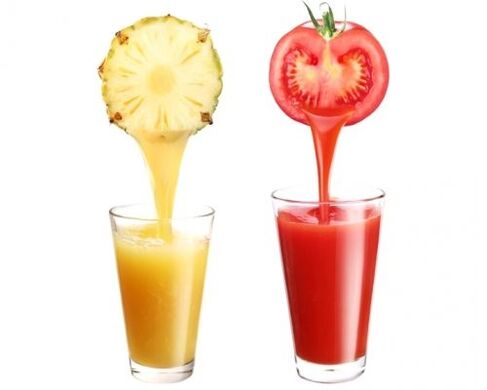
Types of the Japanese diet
There are 3 types of the Japanese diet. The number of days varies:
- 7 days;
- 13 days;
- 14 days.
The diet should be followed regardless of the type of technique.
Diet for 14 days
The salt-free slimming system was designed for 2 weeks. During this period, there is a gradual release and burning of fat cells. In the first 3 days, the body is cleansed. During this period, experts recommend drinking plenty of fluids: boiled water and green tea speed up the elimination of residual toxins. Traditionally, the diet can be divided into 2 stages, each lasting 7 days. In the first stage, kefir is on the menu. The food is steamed, baking and toasting are ignored.
Diet for 7 days
The most gentle technique was designed for a week. You can lose up to 3-4 pounds during this period. The menu is strict, the products are strictly limited and are not interchangeable. During the weight loss period, there is a restructuring during which the body gets used to the new diet, which is why experts consider this system to be the least effective. The menu can include traditional Japanese dishes made from approved ingredients. They cannot be supplemented. For those who think Japanese women plan to lose weight, nutritionists recommend choosing the "easy" option.
Diet for 13 days
The working principle of this type is no different from the previous two. The dose does not exceed 200 g, the liquid is consumed in case of thirst. Meals - at the same time for 13 days. It is mandatory to follow all the rules of detox diet. In less than 2 weeks, the intestines are completely cleansed, The process of fat burning takes place gradually, so the skin retains its elasticity in problem areas. The energy supply used is replaced by protein foods.
Daily diet
The slimming dishes are fully in line with European cuisine and do not contain exotic ingredients. The approximate menu is scheduled for 7 days and will be repeated on day 8. The drinks are varied: replace the coffee with green tea, kefir - tomato juice. The daily norm of the products, if necessary, is divided into 2 parts depending on the number of days (with weekly weight loss).
Diet (for 14 days):
- chicken fillet - 1 kg;
- fish fillet - 2 kg;
- lean beef - 1 kg;
- biscuits or rye bread - 0, 5 kg;
- chicken eggs - 20 pieces;
- white cabbage - 2 pieces;
- zucchini and / or eggplant - 1 kg;
- carrots - 2, 5-3 kg;
- fruits (unsweetened) - 1 kg;
- lemon (large) - 2 pieces;
- kefir (low fat) - 1 l;
- olive oil - (cold pressed) - 0, 5 l;
- tomato juice (homemade) - 1 liter;
- natural coffee (grains or powder) - 1 packet;
- green (large leaf) tea - 1 pack.
The amount of water consumption depends on the age and weight of the person.
The food supply is enough for three meals a day. Non-carbonated mineral water can be replaced by boiled water. The minimum amount of fluid per day is 1, 5 liters.
Detailed plan of the daily menu (daily):
- For breakfast (8. 00) - a cup of weak natural coffee. Cream, sugar, condensed milk should not be added. For lunch (13. 00) - finely chopped cabbage, steamed in its own juice, with a small amount of olive oil, 2 hard boiled eggs and 250 ml of tomato juice. For dinner (18. 00) - fish (200 g boneless fillets), steamed or cooked.
- Breakfast - coffee without milk and sugar, a slice of rye bread. Lunch - cabbage with steamed olive oil and steamed (cooked) fish fillet (100 g). Dinner - boiled beef (100 g) and 250 ml of low-fat kefir.
- For breakfast - a cup of weak natural coffee and a rye croutons. For lunch - vegetable stew made of eggplant or zucchini. For dinner - salad of fresh white cabbage seasoned with oil. You can eat 2 eggs and 200 g of cooked lean beef (pulp).
- Breakfast - raw mashed carrots, lemon juice. Lunch - cooked boneless fish fillet (200 g), 250 ml of tomato juice. Dinner - unlimited fruit.
- For breakfast - raw mashed carrots, lemon juice. For lunch - cooked boneless fish fillet (200 g), a glass of tomato juice. For dinner - fruits in any quantity.
- Breakfast - coffee or green tea without sugar. Lunch - 0, 50 boiled chicken (skinless breast or thigh), fresh vegetable salad (carrots and cabbage) with a little oil. Dinner - boiled chicken eggs (2 pcs. ), Salad of fresh grated carrots with butter.
- For breakfast - green tea without sugar. For lunch - stewed or cooked beef. For dinner - any food (except for the 3-night dinner).
The menu can be displayed schematically. Experts recommend that the sheet with drawings be placed in a conspicuous place.
The right way out of the diet
A kind of dietary diet should be followed 2-4 weeks after the diet. During weight loss, the body gets used to small portions and low-calorie foods. Avoidance of diet is necessary to maintain normal body weight and optimal functioning of the digestive system. We recommend that you gradually return to your normal diet: add a little carbohydrate-rich foods every day. The duration of the issue is at least 14 days.
The meal should be fragmented and the weight of the portion should not be increased. The diet should be dominated by foods that contain small amounts of calories and replenish the energy stored during weight loss. It is not recommended to reduce the amount of protein foods consumed (chicken eggs, poultry and fish). In the menu, fats and carbohydrates are gradually introduced. Salt and sugar can be added in micro doses. The drink should be plentiful, consuming no more than 2 liters per day.
During the withdrawal period, cereals may be consumed for breakfast. Boil the oatmeal, buckwheat and rice flour in water. Vegetables and fruits are consumed raw, in any quantity. It is best to prefer sweet and sour apple varieties. Snacks are introduced between main meals: a glass of kefir or rice cake. Rye bread is replaced by wholemeal or yeast-free bread.
Pasta and sweets, baked goods and snacks are not included in the diet.
The cost of diet
Products approved for use during weight loss are in the middle price range.
Advantages and disadvantages
Japanese weight loss techniques have many advantages and disadvantages. The benefits are:
- efficiency;
- availability;
- cleansing at the same time as losing weight;
- detailed menu;
- Three meals a day;
- increased muscle tone.
The efficiency is due to the fast process of fat burning, the result will appear after 7 days. The products are available to everyone and can be purchased at any store. Calories do not need to be calculated in advance, the menu is clearly written out. Food is taken 3 times a day, the diet is hearty, so hunger is rare. Cleansing the body helps to normalize metabolic processes. Due to the high protein content of foods, the muscle structure is strengthened.
The disadvantages are:
- unbalanced diet;
- lack of vitamins and minerals;
- lack of a hearty breakfast;
- the need to comply with dietary withdrawal rules;
- short-term weight loss;
- contraindications.
An unbalanced diet and non-compliance with the proportions of fats, proteins and carbohydrates increase the risk of side effects. Decreased natural defense reactions, deterioration of nails and hair occur in the background of the body's vitamin deficiency. The right way out of the diet prevents the development of stressful situations that can lead to rapid weight gain.
Contraindications and harms

The diet is only suitable for healthy people. You should examine and consult a nutritionist before losing weight. Contraindications:
- pregnancy at any time;
- breast-feeding;
- gastric and duodenal ulcers;
- erosive damage to the digestive system;
- renal and hepatic pathology, including failure;
- anemia;
- gallbladder disease;
- diseases of infectious etiology;
- cardiovascular pathology;
- hypovitaminosis;
- diabetes;
- increase in blood pressure;
- exacerbation of chronic diseases;
- gout.
The diet is not suitable for the elderly and adolescents. Failure to follow the general rules of the technique increases the risk of side effects. Nausea and stool problems (constipation or diarrhea) may occur in the first few days. Indigestion is accompanied by excessive bloating or colic. Bad breath, heartburn and belching occur. The headache occurs in the background of a complete rejection of sugar.
Neurosis and sleep disorders develop for the same reason. Due to the lack of fat, a bitter taste appears in the mouth. The appearance may deteriorate: the skin will be pale and dry. Lack of nutrients leads to joint pain.
Diet recipes
Diet food will be added to the menu upon exit. You can diversify your diet with salads, first and second courses. Low-sugar, home-made desserts improve brain function and can be consumed in 14-15 days.
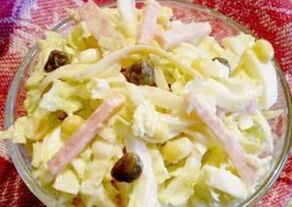
"Hope" diet salad contains the following ingredients:
- potatoes - (2 pcs);
- milk sausage - (2 pcs. );
- chicken breast - (250 g);
- pickled cucumbers - (1 pc. );
- greens;
- salt;
- olive oil - (1 tbsp).
Dice the boiled potatoes, boiled chicken and sausage. The mass is placed in a deep bowl and seasoned with salt. Add the cucumbers cut into strips and the chopped greens.
Season the salad with olive oil (first pressing).
Cabbage salad:
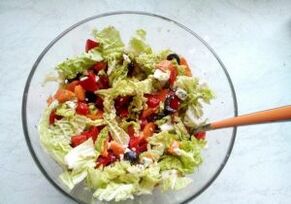
- Peking cabbage - (250 g);
- fresh cucumbers and tomatoes - (250 g);
- chili peppers - (1 pc. );
- hard cheese - (150 g);
- salt;
- olives (1/2 box);
- olive oil.
Chinese cabbage leaves are chopped by hand. Cut the cucumber and tomato into large pieces. Chop (half the vegetables) into small pieces in a blender. Mix all the ingredients, salt and season with oil. The salad is garnished with grated cheese and topped with olives.
The first dishes are eaten at lunchtime. For easier digestion, the soups are made by pureing. Spinach and celery soup:
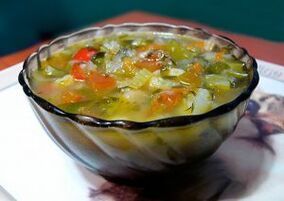
- lemon - (1 db);
- tomatoes - (2 pcs);
- spinach - (200 g);
- celery - (stem, 2 pcs. );
- greens;
- vegetable soup - (1, 5 l);
- salt;
- olive oil - (1 tbsp. l. ).
Pour olive oil into a preheated pan. The celery stalk is finely chopped and evaporated on oil. Bring the broth to a boil in a separate pan, add the chopped spinach and simmer for 5-7 minutes. Remove the peel from the tomatoes and grind in a blender. Add tomato puree to the spinach. Salt the broth, add frying. Cook for 15-20 minutes. Add a little lemon juice and chopped herbs to the finished soup.
Mushroom cream soup:
- champignons - (8 pcs. );
- potatoes - (2 pcs);
- zucchini - (300 g);
- carrots - (1 pc. );
- onions - (1 pc);
- weak broth - (1 l);
- flour - (1 tbsp. l. );
- olive oil - (2 tbsp. l. );
- cream - (1 tbsp. l. ).
The cooked vegetables are cut into small cubes and chopped in a blender. Bring the soup to a boil. Bake the flour until golden brown, add to the broth and add the vegetable puree. Simmer the soup over a low heat until it thickens, then salt, add the cream and garnish with herbs. The first dish is served with rye croutons.
Beef stew with vegetables:
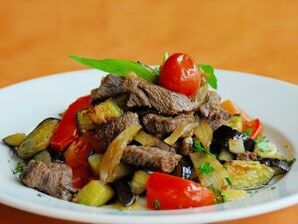
- beef - (500 g);
- olive oil - (3 tbsp. l. );
- potato - (200 g);
- carrots - (1 pc. );
- paprika - (1 db);
- onions - (1 pc. ).
In olive oil, smear onions, peppers and grated carrots in half rings. The beef is half cooked, cooled and cut into small sticks. Place the meat on fried vegetables, salt. Put potatoes cut into strips on top. Salt again. Pour the broth into the vegetables. Cook the dish on low heat for 25-30 minutes.
Indian manti is a diet food prepared in 2 stages. Ingredients for the dough:
- flour - (1, 5 cups);
- hot water - (1 glass);
- salt.
Dissolve salt in warm water. Pour flour on the work surface, make a recess in it. Pour in portions into salted water, gradually kneading through the elastic dough. Cover with a towel and leave for 15-20 minutes.
While the dough "fits", you need to prepare the dressing. Necessary parts:
- champignons - (6-8 pcs. );
- carrots - (1 pc. );
- green onion - (4-5 feathers);
- zucchini - (400 g);
- olive oil - (2 tbsp. l. );
- tomato puree - (2 tbsp. l. );
- chicken fillet - (400 g).
Cut the mushrooms, zucchini and carrots into small cubes. Bring the chicken fillet to a boil and cut into strips. Fry the onion in oil and tomato puree, gradually add the carrots, zucchini, mushrooms and meat. Pour 150-200 ml of water into the oven and simmer the vegetables until soft.
The dough is stretched into thin strips and each is smeared with oil. Cut the strips into squares (10x10 cm) that are stacked on top of each other. Simmer the dough in a high-speed cooker or slow cooker for 15-20 minutes. The "columns" of the dough are placed on a pan, poured with vegetable sauce and sprinkled with herbs.
Results and opinions
You can lose 8-9 kg in 2 weeks. Most women and men who have lost weight with this technique talk about it positively.
First review, woman, 36 years old
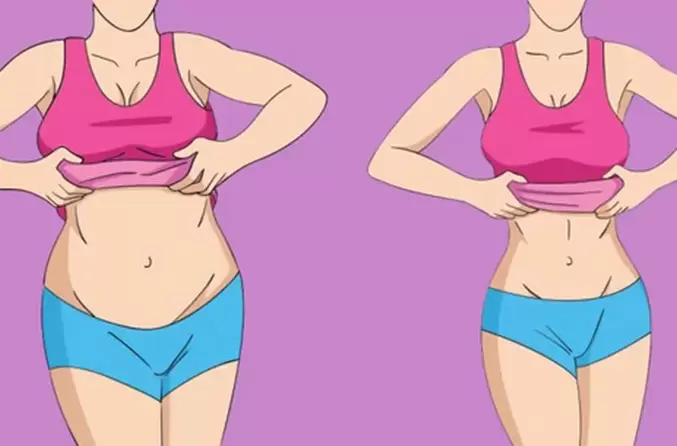
I started recovering in adolescence, I tried a lot of diets - they didn’t help. I went to a nutritionist, underwent a medical examination, ate separately, counted calories all the time, arranged fasting days, and was able to lose just 2 pounds in 5 months. The Japanese fat burning system was advised by a friend of mine, I failed to lose 7kg in 2 weeks. I decided to give it a try.
The medical examination revealed no contraindications. The nutritionist gave detailed dietary recommendations. The system does not require large financial investments. On the advice of the doctor, he painted the menu in detail, attaching the sheet to the refrigerator. I almost fell in the first 3 days: the doses seemed small, the feeling of hunger was constantly present. On day 4, it was easier, I tried to continue to chew the food and drink more fluids.
The second phase of weight loss flew quickly. I cooked on the machine: I remembered the ingredients in the food and their weight. The food seemed satisfactory, the hunger was virtually gone. There were no side effects except for the short-term headache on day 3. The dietitian explained that this was due to sugar deficiency. I left the diet for 20 days. I liked the food at the exit, so I completely left out the sweet, greasy, salty and smoked food. I am satisfied with the result: I lost 10. 5 kg in 2 weeks. I will be using this weight loss system again in six months.
Second Assessment, female, 28
I learned the technique 2 years ago. It was 107 kg at the time, with 164 increases, a number that is critical. There were health problems and I wasn’t happy with the look. His friends could not advise on an effective diet, so he decided to consult a specialist. Your doctor has suggested that you try to lose weight using the Japanese weight loss system. The long food list was frightening at first, but the nutritionist reassured him and explained the diet in detail.
It took 5 kg for 7 days. The dishes from the menu are hearty, I ate a serving. At first, mild dizziness and mild intestinal upset occurred. The side effects alone are gone. He ate food at the same time. The second phase of weight loss was easy: lightness, appearance, and general well-being improved. Thanks to the diet, I quit smoking and completely gave up alcohol. 13 kg was lost during the release period. I have been eating, swimming and jogging properly for 1, 5 years, my previous weight has not returned.

















































































